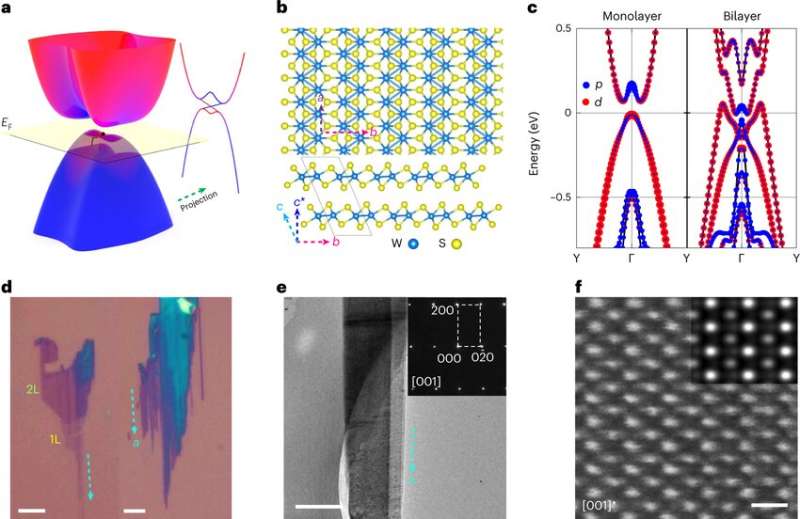December 21, 2022 feature
Study observes spin-orbit-parity coupled superconductivity in thin 2M-WS2

In recent years, many physicists and material scientists have been studying superconductors, materials that can conduct direct current electricity without energy loss when cooled under a particular temperature. These materials could have numerous valuable applications, for instance generating energy for imaging machines (e.g., MRI scanners), trains, and other technological systems.
Researchers at Fudan University, Shanghai Qi Zhi Institute, Hong Kong University of Science and Technology, and other institutes in China have recently uncovered a new mechanism to generate anisotropically-enhanced in-plane upper critical field in atomically thin centrosymmetric superconductors with topological band inversions. Their paper, published in Nature Physics, specifically demonstrated this mechanism on a thin layer of 2M-WS2, a material that has recently attracted much research attention.
"In 2020, a paper by our theoretical collaborator Prof. K.T. Law proposed that 2D centrosymmetric superconductors with a topological band inversion, such as 1T′-WTe2 exhibit a distinct type of superconductivity, called spin-orbit-parity coupled (SOPC) superconductivity," Enze Zhang, one of the researchers who carried out the study, told Phys.org.
"SOPC is predicted to produce novel superconductivity near the topological band crossing with both largely enhanced and anisotropic spin susceptibility with respect to in-plane magnetic field directions. At that time, we were conducting research on the superconducting properties of atomically thin 2M-WS2, so after talking with Prof. K.T. Law, we felt that the emergent van der Waals superconductor 2M-WS2 would most likely be a promising candidate for spin-orbit-parity coupled superconductivity."
The structure of monolayer 2M-WS2 is identical to that of 1T′-WTe2, the material previously investigated by Prof. Law and his team. 2M-WS2, however, has a unique stacking mode, which distinguishes it from other transition metal dichalcogenides.
The researchers previously found that in its bulk form, this material exhibit a high superconducting transition temperature TC of 8.8 K. In addition, theoretical calculations suggested that atomically thin layers of 2M-WS2 hold topological edge states with band inversion.
In their experiments, Zhang and his colleagues measured the in-plane upper critical field at a high magnetic field and confirmed the violation of the Pauli limit law. They also observed a strongly anisotropic two-fold symmetry in the material, in response to the in-plane magnetic field direction.
"Tunneling experiments conducted under high in-plane magnetic fields also showed that the superconducting gap in atomically thin 2M-WS2 possesses an anisotropic magnetic response along different in-plane magnetic field directions, and it persists much above the Pauli limit," Zhang explained. "Using self-consistent mean-field calculations, our theoretical collaborators conclude that these unusual behaviors originate from the strong spin-orbit-parity coupling arising from the topological band inversion in 2M-WS2."
The researchers' experiments spanned across several steps. Firstly, the team performed magneto-transport measurements on atomically thin 2M-WS2 and found that its in-plane upper critical field is not only far beyond the Pauli paramagnetic limit, but also exhibits a strongly anisotropic two-fold symmetry in response to the in-plane magnetic field direction.
Subsequently, they used tunneling spectroscopy to collect measurements under high in-plane magnetic fields. These measurements revealed that the superconducting gap in atomically thin 2M-WS2 possesses an anisotropic magnetic response along different in-plane magnetic field directions, which persists much above the Pauli limit.
Finally, the researchers performed a series of self-consistent mean-field calculations to better understand the origin of the unusual behaviors they observed in their sample. Based on their results, they concluded that these behaviors originate from the strong spin-orbit-parity coupling arising from the topological band inversion in 2M-WS2, which effectively pins the spin of states near the topological band crossing and renormalizes the effect of external Zeeman fields anisotropically.
"We uncovered a new mechanism for generating an anisotropically-enhanced in-plane upper critical field in atomically thin centrosymmetric superconductors with topological band inversions, highlighting 2D 2M-WS2 as a wonderful platform for the study of exotic superconducting phenomena such as higher-order topological superconductivity and further device applications," Zhang said.
"The novel properties found here are highly nontrivial as they directly reflect a strong SOPC inheriting from the topological band inversion in the normal state of 2M-WS2, which had been ignored for many years in previous studies of centrosymmetric superconductors."
In recent years, more research teams worldwide have been exploring the properties and mechanisms of centrosymmetric superconducting transition metal dichalcogenides (TMDs), such as monolayer superconducting 1T′-MoS2, and 1T′-WTe2, due to the characteristic co-existence of topological band structure and superconductivity within them.
The recent paper by Zhang and his colleagues could pave the way towards the exploration of large enhanced and strongly anisotropic in-plane upper critical fields, which could further improve the current understanding of these materials' exotic physics.
"We now plan to explore the usual superconducting properties (such as the in-plane upper critical field and tunneling spectroscopy behavior at high magnetic field) of more atomically thin centrosymmetric superconductors with topological band inversions," Zhang added.
More information: Enze Zhang et al, Spin–orbit–parity coupled superconductivity in atomically thin 2M-WS2, Nature Physics (2022). DOI: 10.1038/s41567-022-01812-8
Ying-Ming Xie et al, Spin-Orbit-Parity-Coupled Superconductivity in Topological Monolayer WTe2, Physical Review Letters (2020). DOI: 10.1103/PhysRevLett.125.107001
Journal information: Physical Review Letters , Nature Physics
© 2022 Science X Network


















